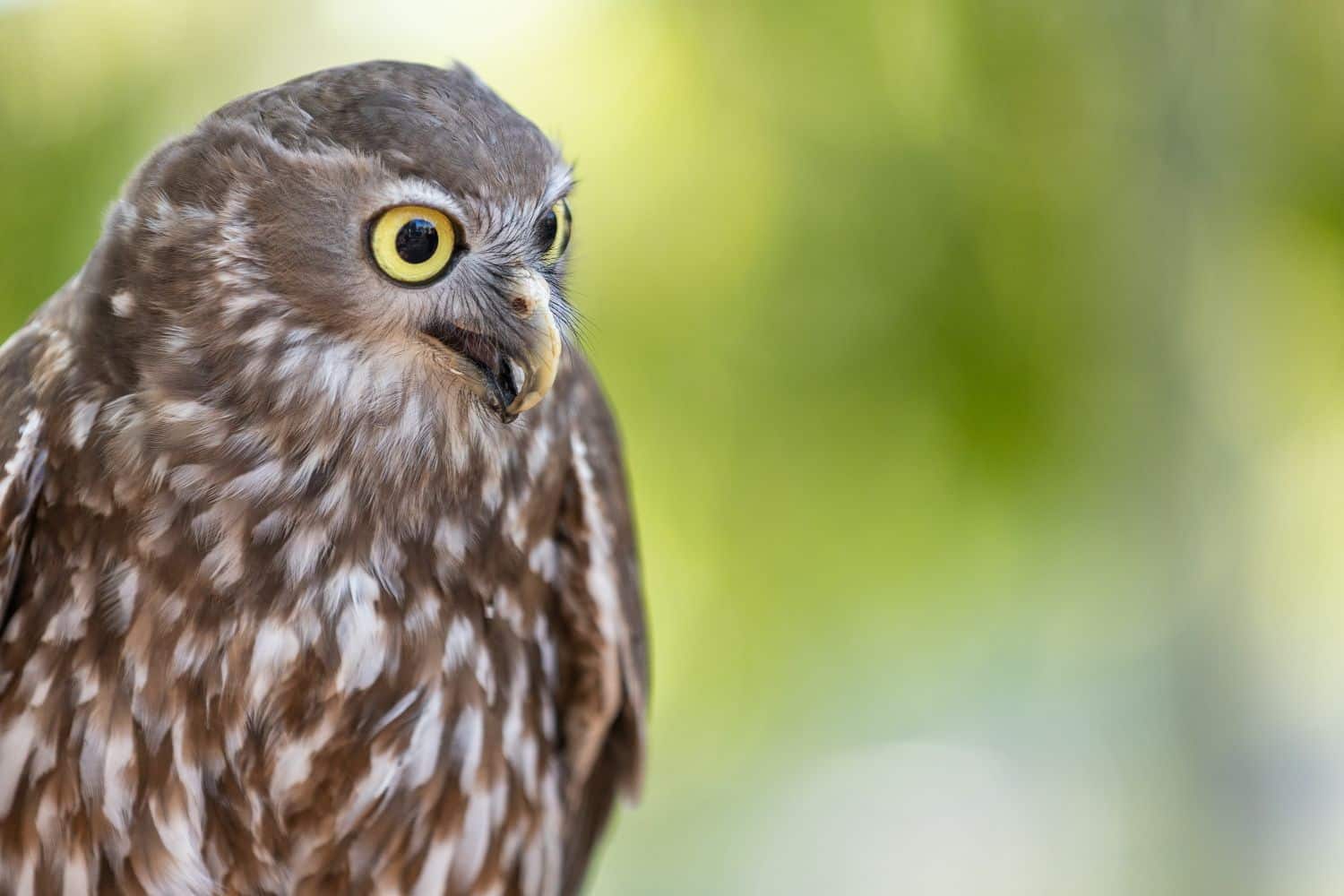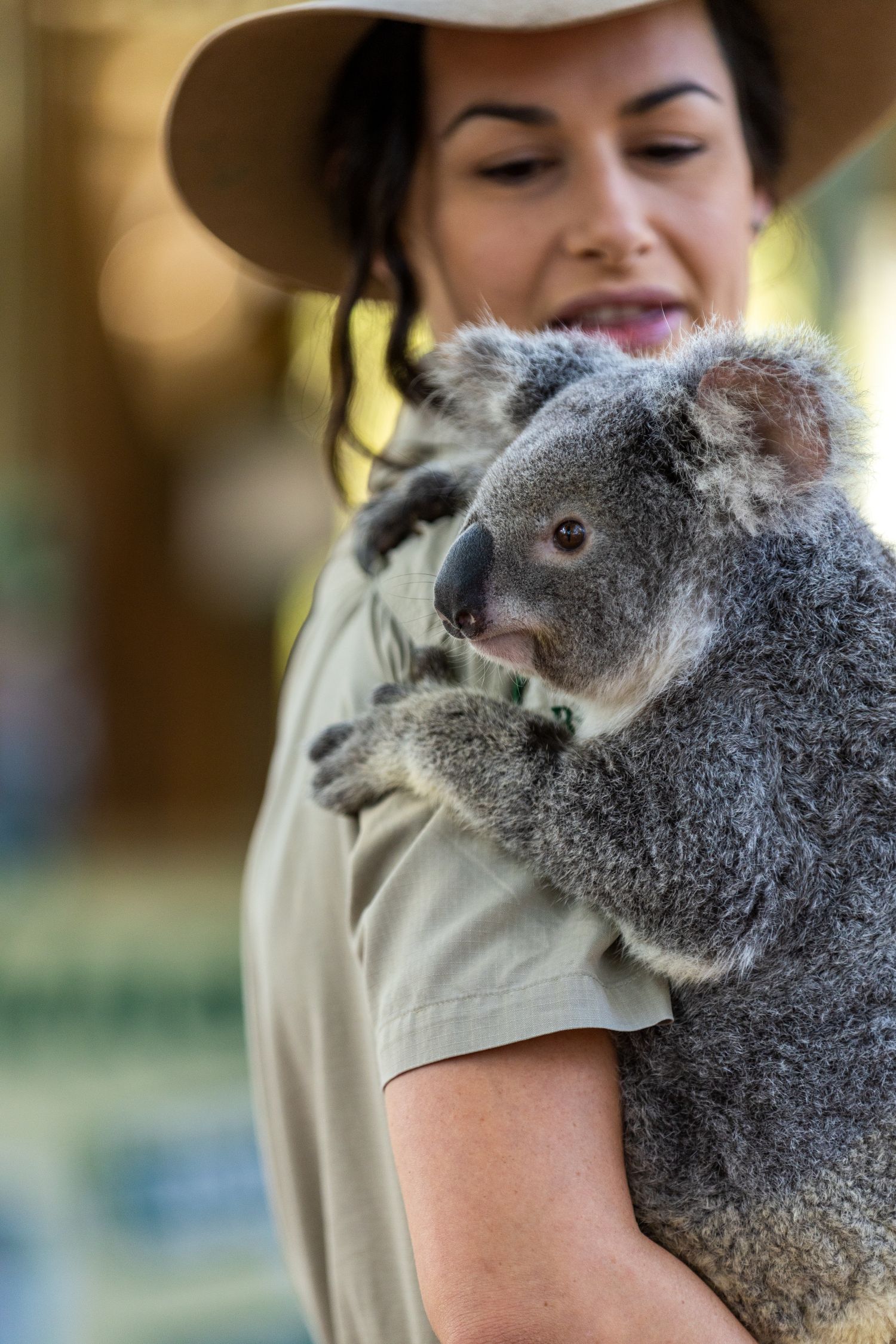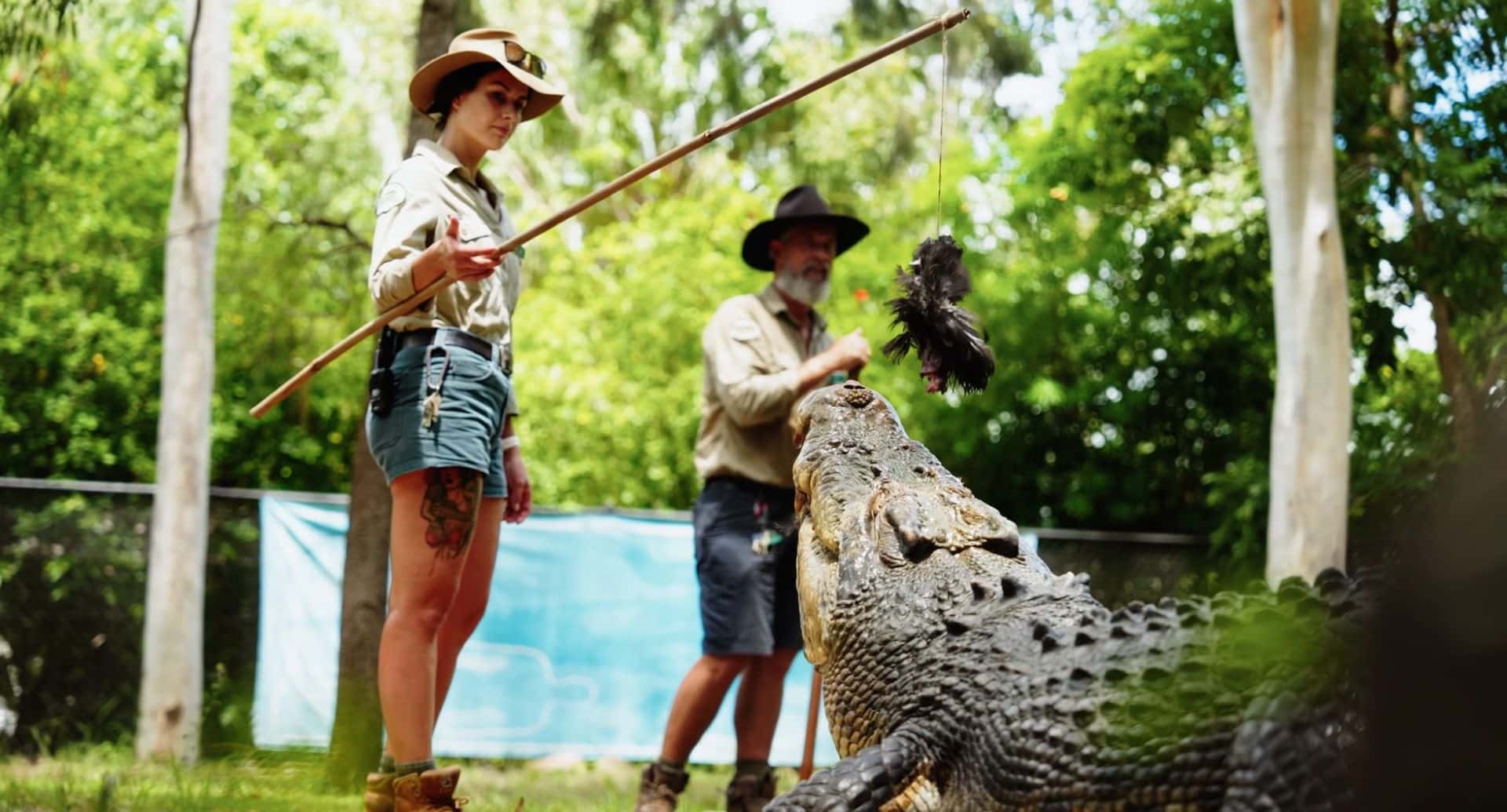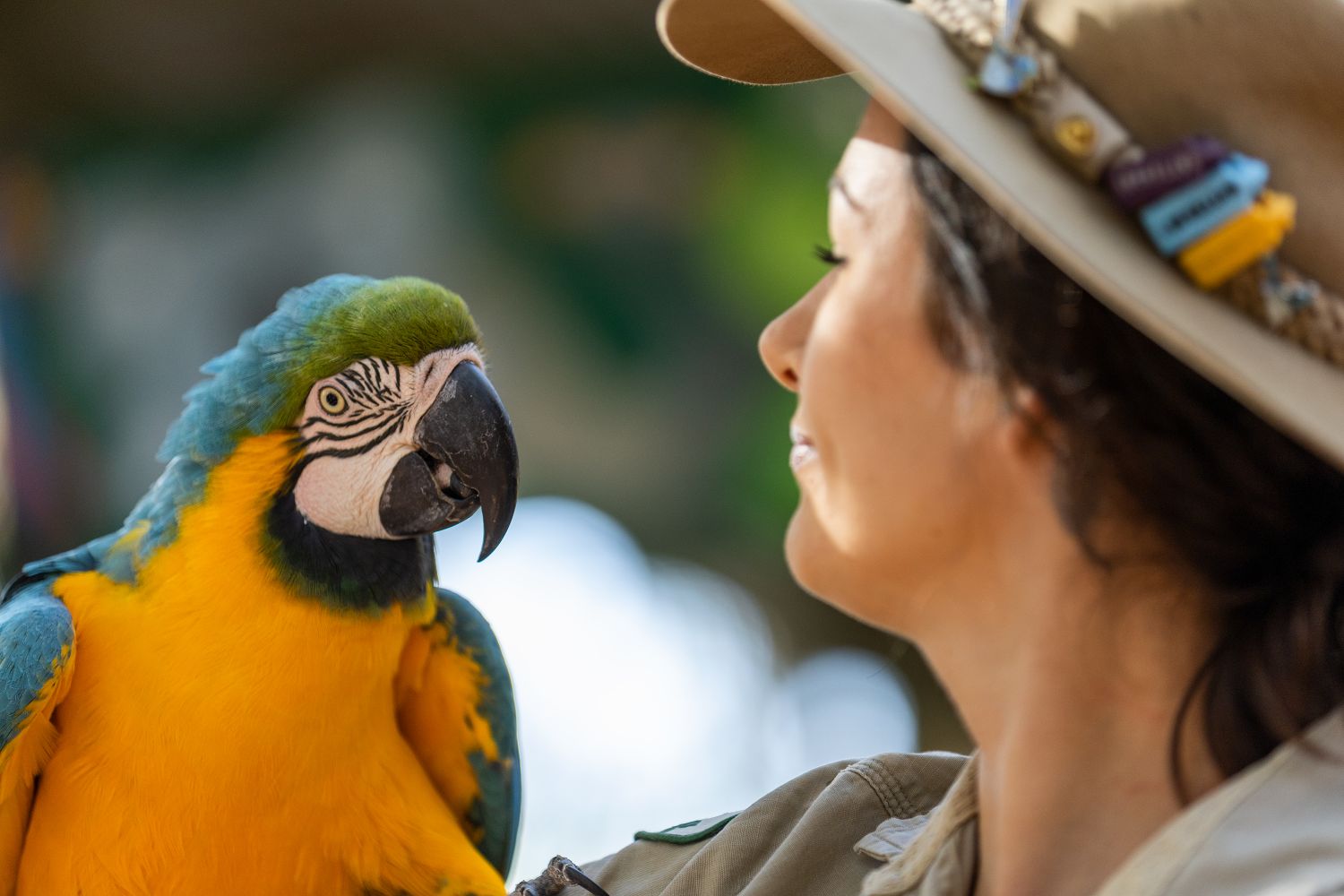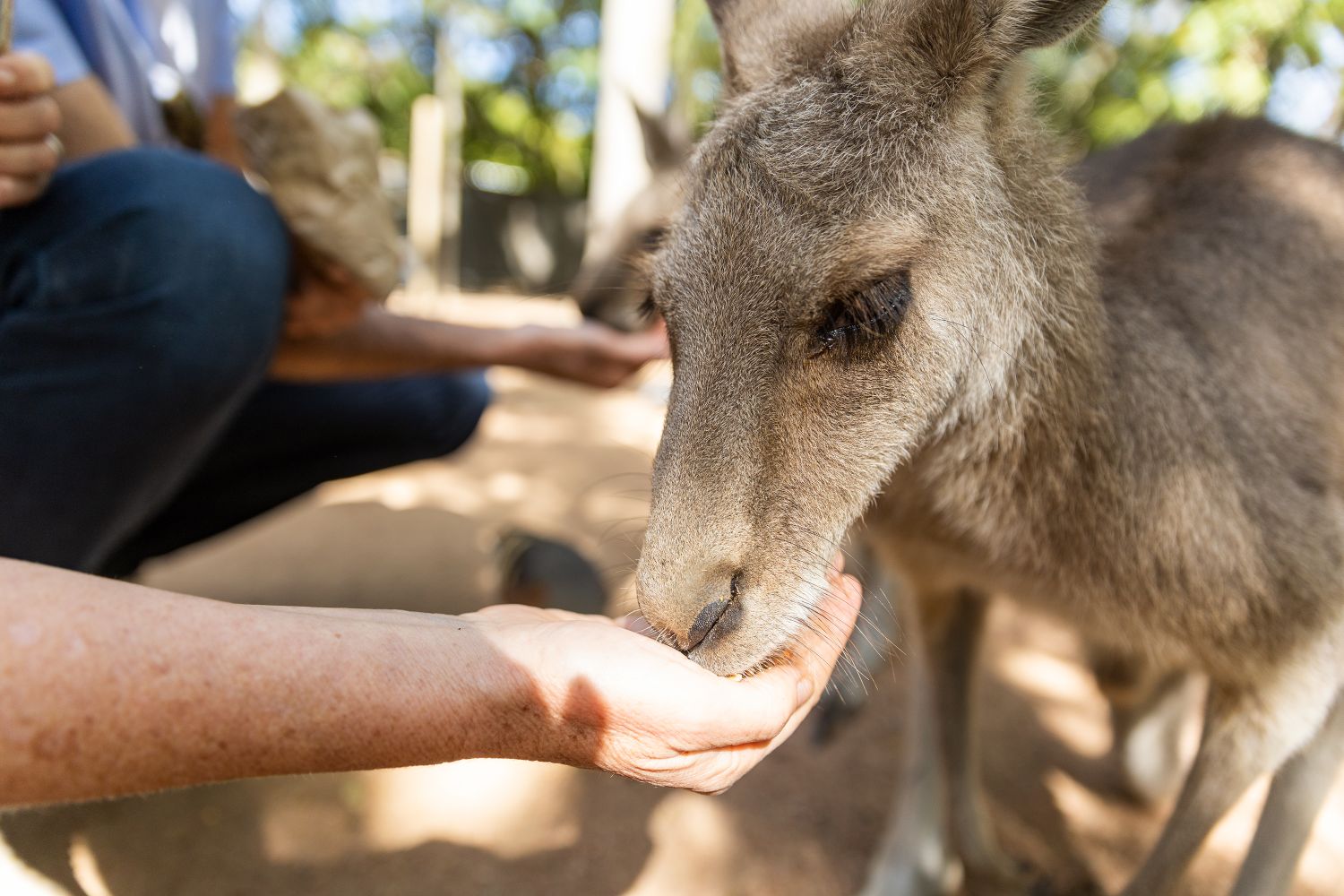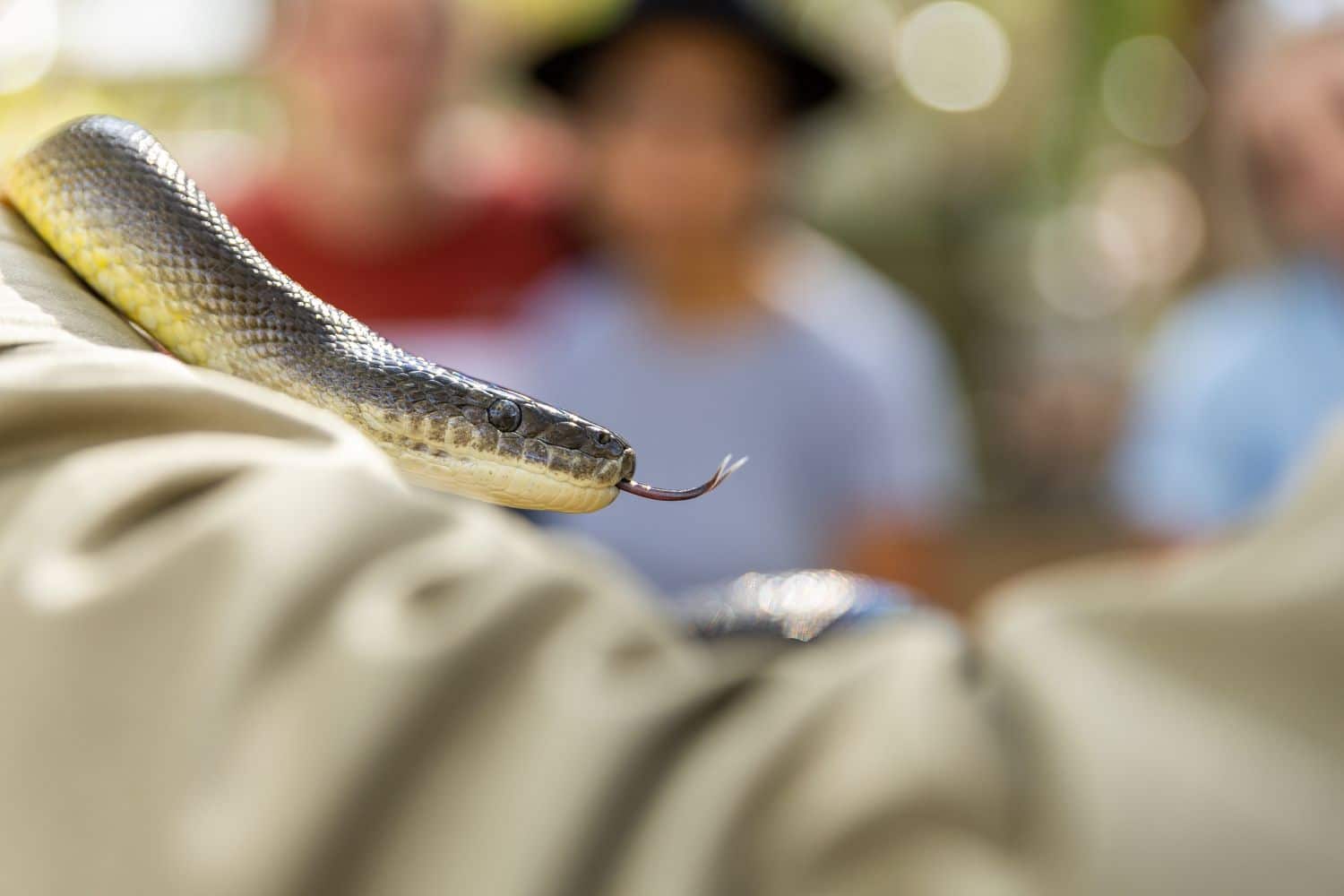Does this make the Australian bush a dangerous place to visit? Not necessarily! The chances of stumbling across any one of these potentially deadly reptiles in the wild are extremely small. The probability of actually getting bitten is even smaller.
Visitors to Billabong Sanctuary can have a close look at some of these fascinating reptiles, including the Coastal Taipan, safely housed in large enclosures. Rather than fearing these awesome snakes, we should try to understand their amazing adaptations for life in the Australian bush.
WHAT’S IN A NAME?
‘Taipan’ is the name given to these snakes by Aboriginal people of Cape York Peninsula. The Coastal Taipan is also called the Eastern Taipan.
Taipans belong to the Elapidae family of snakes. Members of this family are all venomous, with relatively short fixed fangs at the front of the jaw.
The genus name is from Greek oxys (sharp, needle-like) and ouranos (an arch, specifically the arch of the heavens), and refers to the needle-like anterior process on the arch of the palate. This skeletal feature differentiates the taipan from all other elapids.
The species name scutellatus means ‘shaped like a small flat dish’, a reference to the smooth, flat scales. Thus, Oxyuranus scutellatus means ‘flat-scaled snake with a needle-like palatine process’.
Our thanks to David Meagher, School of Biosciences, University of Melbourne, for clarifying the meaning of this scientific name.
Meagher, David (2012). An etymology of the scientific names of Victorian snakes. The Victorian Naturalist 129(1): 54-60.
WHAT DOES IT LOOK LIKE?
In general, you can’t positively identify most Australian snakes just by their colour. Positive identification is made by counting rows of scales across the back in mid-body, and by comparison of the pattern of scales on the head – not usually practical in the bush!
Knowledge of both the appearance and the behaviour of all snakes in a particular area not only helps deepen our understanding and appreciation of their remarkable adaptations but may prevent unwelcome confrontations.
Taipans are long, slender snakes with a whip-like tail.
The Coastal Taipan is usually a uniform light to dark brown above, but it may be almost black in colour. The belly is creamy or yellow, with irregular yellow or orange spots.
During winter months the scales tend to darken in colour, perhaps to help the Taipan absorb heat from the sun while basking.
The head is long and deep, and distinct from the neck. It is often described as ‘coffin-shaped’. A distinctive feature is the band of cream colour that wraps around the nose and along the jaw line. There is a distinct ridge above the eye, which has an orange iris.
By contrast, the Eastern Brown snake has a short, rounded head which is not distinct from the neck, and lacks the cream-coloured snout.
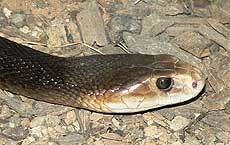 The body is robust, with an average length of 2.5m ( 8.1 ft). A maximum length of 3.35m ( 10.9 ft) has been recorded! This makes the Coastal Taipan Australia’s longest venomous snake.
The body is robust, with an average length of 2.5m ( 8.1 ft). A maximum length of 3.35m ( 10.9 ft) has been recorded! This makes the Coastal Taipan Australia’s longest venomous snake.
Taipans are terrestrial and usually hunt by day, except during very hot weather. Many non-venomous species such as pythons and tree snakes are nocturnal, and often climb trees or up into rafters or the roof of buildings.
They are not usually aggressive, but prefer to retreat to shelter unless cornered or provoked. If they do feel threatened, they coil into an s-shape, lift up the front of the body and vibrate the end of the tail.
WHERE IS IT FOUND?
The Coastal Taipan is found all along the eastern coast of Queensland, down into the extreme northeastern corner of New South Wales. It is also found in the northern part of the Northern Territory, and the Kimberley region of Western Australia. Its range is discontinuous, in that it does not occur along the southern coast of the Gulf of Carpentaria, in between these two coastal areas of distribution.
The Coastal Taipan occupies a wide range of habitats, from tropical wet sclerophyll forest to dry sclerophyll forest and open savannah woodland.
It shelters in abandoned animal burrows, under roots and fallen timber, in hollow logs, and in deep leaf litter. It is also attracted to rubbish dumps, discarded building materials, and sugarcane windrows, as these places also shelter rats and mice.
WHAT DOES IT EAT?
All Coastal Taipans, even hatchlings, feed almost exclusively on mammals and birds. Lizards are eaten only occasionally. Bandicoots are a favourite food of adults. They also eat small native rodents such as Melomys and marsupials such as Quolls. Coastal Taipans have also developed a taste for introduced domestic rats and mice, and so are attracted to farm buildings and sugar cane plantations.
ADAPTATIONS FOR THIS DIET
Taipans detect their prey by sensing movement and odour. They seem to have better eyesight than many other snakes. They flick their forked tongue rapidly in and out of the mouth, ‘tasting’ the presence on the air of potential prey animals. This chemical information is passed to the Jacobson’s organ in the roof of the mouth, and then to the brain.
Having located its prey, the Taipan strikes incredibly fast, biting its victim, and then immediately retreating to wait till it dies. This is called the ‘strike and release’ hunting method and is exclusive to Taipans.
The extreme toxicity of the venom means that the prey animal will die very quickly; then the snake has to follow its scent for only a short distance to find its meal.
There are advantages to this method of hunting food. An animal such as a bandicoot has sharp claws and teeth and will fight back viciously when attacked; but because it is so quickly immobilized by the venom, the Taipan does not have to risk being injured or bitten itself by its victim, nor does it have to expend energy struggling to hold onto the victim till it dies.
Now the snake is faced with its meal – possibly a bandicoot or large rat – that is many times larger in diameter than its own body. Snakes can’t rip their food apart, so they need to swallow their victim whole. This is a formidable undertaking! Imagine you or me having to swallow an entire melon without chewing it into bite-size pieces!
Snakes have amazing adaptations that allow them to swallow their prey whole:
First, they nudge the victim until it is correctly aligned so that they can swallow it headfirst. This way, they are not going against the grain of fur, feathers, or spikes on their prey.
The two halves of a snake’s lower jaw are not fused in the middle, but are held together by flexible muscles and ligaments. This allows them to stretch incredibly far apart as the animal is swallowing.
The upper and lower jaw do not ‘unhinge’ as is commonly believed. Instead, the food passes below this joint along the bottom of the neck, which can stretch enormously around the prey animal.
In order to move the food along, the snake grips it with the fangs on alternate sides of the jaw, moving one side of the jaw and then the other along the prey, passing it down its throat. During this process it produces huge amounts of saliva to lubricate the prey as it moves along.
The ribs of a snake are not anchored to a breastbone (as in other animals, including people) so the tips of the ribs can stretch apart as the food moves on down the snake’s body.
The skin of the snake is also very stretchy, with relatively small scales. This enables the body to expand hugely as the food item is swallowed.
It can take several hours to swallow a large animal. After eating large prey, the snake will usually spend much time basking in the sun to maintain a high enough body temperature to digest the meal. The venom, which stopped the victim in its tracks, now helps to digest it—powerful enzymes in the venom help break down the tissues of the dead animal.
The ability to swallow very large food items means that a big snake need not expend energy on frequent hunting activities. It may need to eat only a few meals every year.
SNAKES IN LOVE: BREEDING BEHAVIOUR
Mating occurs anytime from March to December, but peaks from July to October. This is springtime in Australia, when conditions for incubating eggs are optimal; the rainy season is approaching so the eggs won’t dry out, and food for hatchlings will be more abundant.
If more than one male Taipan encounters a female, they will engage in a spectacular display called ritualistic combat. In this test of strength, they wrap around each other’s bodies like a coiled rope, wrestling with each other till the stronger snake forces his rival’s head to the ground. The struggle may last for hours, until the stronger male finally wins the right to mate with the female.
If the female is receptive, he rubs his chin up and down her body, then twists the lower part of his body under hers. Males have two sex organs, called hemipenes, but only one at a time is used for mating. Mating may last for several hours, and a female may mate with more than one male during the breeding season.
From 52 to 85 days after mating, the female lays up to 22 eggs, with an average clutch size of 14 eggs. Older females (which have a larger body size) generally lay more eggs than younger ones. Taipan eggs are elongated in shape, with a leathery, permeable shell. Females will not usually mate every year because of the high energy costs and risks associated with reproduction.
Eggs are laid in an abandoned animal burrow, or in loose soil under a rock or tree root. The nest site must be damp because right after they are laid the eggs must absorb a large amount of water, which the embryo needs for development. Soon after laying, the female will abandon the nest and have nothing further to do with her offspring.
The eggs hatch two to three months later, depending on the air temperature and humidity. Higher temperatures increase the rate of metabolism, allowing eggs to hatch sooner.
Hatchlings are about 600mm in length (23.6 in) and grow very fast under favourable conditions. Male Coastal Taipans reach sexual maturity at about 16 months of age, and females at about 28 months of age.
Little is known about their life expectancy in the wild; snakes in captivity reach 10 -15 years of age.
JUST HOW DANGEROUS IS IT?
The venom of the Coastal Taipan is rated as the third most toxic of all snake venoms in the world (behind those of the Inland Taipan and the Eastern Brown, which are also Australian snakes!).
The accepted standard for comparing the toxicity of snake venoms was devised in the 1970s by the Commonwealth Serum Laboratory (CSL) in Melbourne. Tests were done by injecting live mice and measuring the amount of venom required to kill 50% of test animals, yielding a number called LD50 (or Lethal Dose 50): the smaller the number, the more toxic the venom. The LD50 of the Coastal Taipan is 0.099 mg/kg. Expressed in other units, a single bite could kill nearly 100,000 mice.
The actual number for any particular snake doesn’t really mean all that much (except to all those mice!): dead is dead. The relative danger of venomous snakes depends on many factors, such as the amount of venom injected, the length of the fangs, the sensitivity of the victim to the toxin, and the likelihood of getting bitten in the first place.
The venom of a Coastal Taipan contains a cocktail of poisons. The most powerful ingredient is a neurotoxin which paralyses the nerves of the heart, lungs and diaphragm, suffocating the victim. It also contains a powerful myotoxin, which destroys muscle tissue, and a procoagulant which causes abnormal clotting leading to internal bleeding.
Coastal Taipans have the longest fangs of all Australian snakes- up to 13mm, or half an inch long! They are also the longest venomous snake in Australia. They strike extremely quickly, and can inflict multiple bites and inject large amounts of venom – up to 60mg.
Because they hunt rats and mice, Coastal Taipans sometimes occur close to populated areas, seeking out their prey in barns and sugarcane fields. This brings them into contact with humans more often than Inland Taipans, which have a more toxic venom but live in remote inland regions.
Taipans have a reputation for aggressiveness, but will actually avoid close contact with humans if possible. A snake isn’t going to waste energy or venom attacking something that isn’t good to eat, or that isn’t about to attack. We’re not on the menu for Taipans, so they will only try to bite us if they feel threatened. If provoked, however, they will gather the body into loose coils and strike extremely fast, often inflicting multiple bites.
By far the most bites occur when people try to kill or to catch snakes.
Since the development of Taipan antivenene in 1955, recorded deaths from Taipan bites have been very rare.
On average, Australia records fewer than 5 fatalities a year from snake bite.
Many more of these occur from the bite of the Eastern Brown than from Coastal Taipan bites.
By contrast, venomous snakes such as cobras and vipers cause tens of thousands of deaths per year in the very densely populated continents of Africa and Asia.
The Taipan is a very large, very venomous snake, but the chances of a person being bitten and killed are extremely low. More people are killed in Australia every year by horses or bee stings than from snake bite. If we leave snakes alone, they will leave us alone.
FIRST AID
Anyone out and about in the Australian bush should carry a couple of broad elastic pressure bandages and become familiar with the first aid procedures to follow after any snake bite.
All Australian hospitals and medical clinics carry antivenenes specific to each species of snake, as well as kits that enable the staff to identify the type of snake by taking a swab of the bite site. It is not necessary to kill or capture the snake in order to identify it. You are just putting yourself at added risk of being bitten.
STATUS IN THE WILD
Coastal taipans are common in many parts, and are not considered to be endangered. In many areas they have probably increased in abundance since human settlement because of the proliferation of introduced animals like rats and mice.
All snakes in Australia are protected by law. In Queensland the Nature Conservation Act (1992) prohibits killing or capturing wild snakes (unless they are threatening life). Any snakes in captivity have been bred and sold by licensed breeders.
Taipans are extremely efficient hunters, beautifully adapted to their niche in the Australian bush. They deserve our healthy respect.



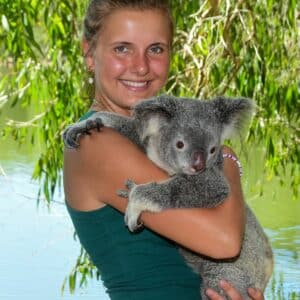
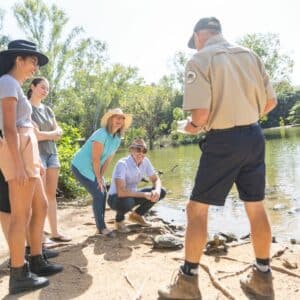
 The body is robust, with an average length of 2.5m ( 8.1 ft). A maximum length of 3.35m ( 10.9 ft) has been recorded! This makes the Coastal Taipan Australia’s longest venomous snake.
The body is robust, with an average length of 2.5m ( 8.1 ft). A maximum length of 3.35m ( 10.9 ft) has been recorded! This makes the Coastal Taipan Australia’s longest venomous snake.